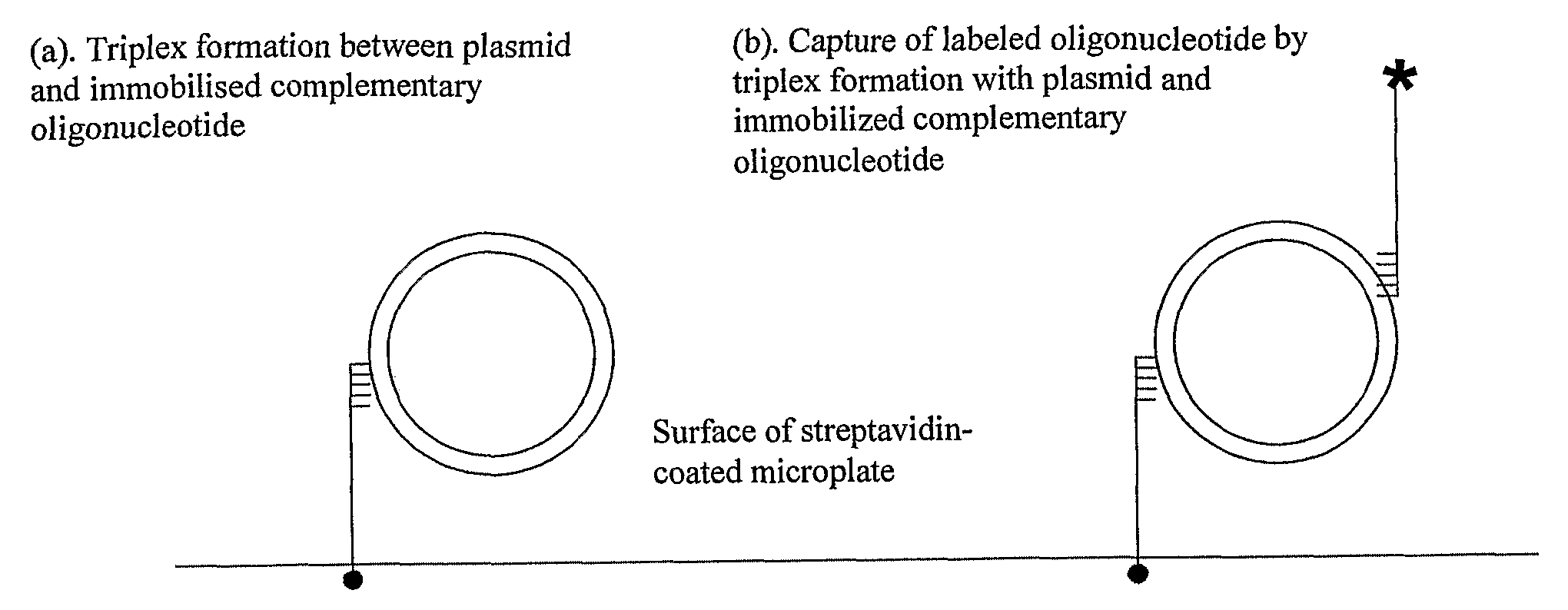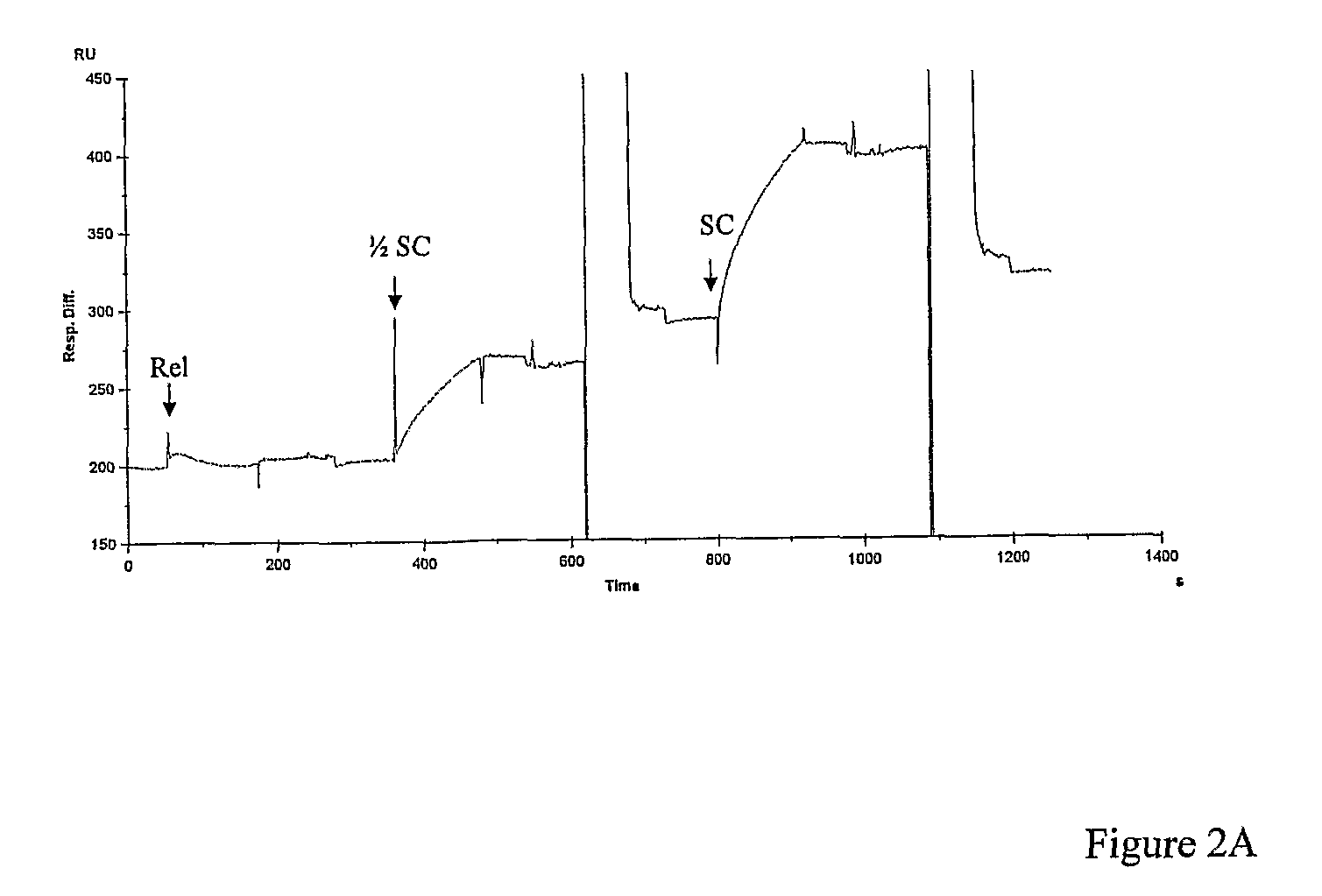Assay for Measuring an Enzyme's Capability to Modify Supercoil Topology of Nucleic Acids and Modulators
a technology of supercoil topology and enzyme, which is applied in the direction of enzymes, sugar derivatives, biochemistry apparatus and processes, etc., can solve the problems of difficult monitoring of the basic reaction catalyzed by these enzymes, the inter-conversion of relaxed and supercoiled dna, and the inability to achieve known assays. the ability to achieve the effect of supercoil topology and modulator
- Summary
- Abstract
- Description
- Claims
- Application Information
AI Technical Summary
Benefits of technology
Problems solved by technology
Method used
Image
Examples
example 1
[0128] Preparation of Test Nucleic Acid for Supercoil / Relaxation Testing:
[0129] To enable specific capture of plasmids by triplex formation with immobilised oligos, plasmids containing triplex-forming sequences were constructed. To construct plasmid pNO1, oligos TFO1W and TFO1C (Table 1) were annealed and ligated into the AvaI site of pBR322*. To construct plasmid pNO11, oligos TFO2W and TFO2C (Table 1) were annealed and ligated into the AatII site of pNO1. The sequences of pNO1 and pNO11 were verified by DNA sequencing. Supercoiled forms of plasmids were prepared by transforming them into Top10 competent cells (Invitrogen) and growing in LB broth containing ampicillin (Sigma), and preparing the DNA using Qiagen mini and midi prep kits. Relaxed plasmids were prepared by incubating the supercoiled forms with topo I (˜40-50 μg plasmid, 200 units topo I, in 50 mM Tris.HCl (pH 7.5), 50 mM NaCl, 0.1 mM EDTA), for 1 h at 37° C. Relaxed plasmids were purified by phenol / chloroform extracti...
example 2
[0131] Surface Plasmon Resonance (SPR):
[0132] We used SPR to demonstrate plasmid capture by TFOs and to optimise conditions for triplex formation. The TFO was first immobilised onto one of two flow cells using a streptavidin-coated chip and a biotinylated oligo. The plasmid was then injected over the flow cells. Any bound plasmid was subsequently washed off to regenerate the chip. In control experiments we found that plasmids with multiple triplex-forming inserts were captured less efficiently than those with single inserts (data not shown). When the solution conditions were varied, we found that a metal ion was required (MgCl2), salt was required (either NaCl or KCl) and that low pH is optimal (pH˜5); the best buffer for triplex formation was found to be: 50 mM sodium acetate (pH 5), 50 mM NaCl and 50 mM MgCl2 (=TF Buffer). Under these conditions we evaluated the capture of negatively supercoiled, relaxed and partially supercoiled pNO1 by TFO1 (FIG. 2A,B). These experiments showed...
example 3
[0134] DNA Gyrase Assay According to this Invention—Microplate DNA Gyrase Supercoiling Assay Using a Single Triplex Forming Oligonucleotide:
[0135] Having observed plasmid capture by triplex formation using SPR, we transferred these principles to a microplate format. Biotinylated TFO1 was bound to the streptavidin-coated surface of microtitre plates to which plasmids were applied in TF Buffer. Any unbound plasmids were subsequently washed off using the same buffer. The wells were then stained with the nucleic acid stain SYBR Gold and any fluorescence detected using a microplate fluorescence spectrometer. FIG. 3 shows the results of such an experiment using pNO1 and pNO11. As before, the supercoiled form of the plasmids is preferentially captured.
[0136] To investigate the utility of this assay for DNA topoisomerases, a DNA gyrase supercoiling assay was carried out in a microplate format using a range of gyrase concentrations; samples were removed from the wells after incubation with...
PUM
| Property | Measurement | Unit |
|---|---|---|
| pH | aaaaa | aaaaa |
| pH | aaaaa | aaaaa |
| pH | aaaaa | aaaaa |
Abstract
Description
Claims
Application Information
 Login to View More
Login to View More - R&D
- Intellectual Property
- Life Sciences
- Materials
- Tech Scout
- Unparalleled Data Quality
- Higher Quality Content
- 60% Fewer Hallucinations
Browse by: Latest US Patents, China's latest patents, Technical Efficacy Thesaurus, Application Domain, Technology Topic, Popular Technical Reports.
© 2025 PatSnap. All rights reserved.Legal|Privacy policy|Modern Slavery Act Transparency Statement|Sitemap|About US| Contact US: help@patsnap.com



